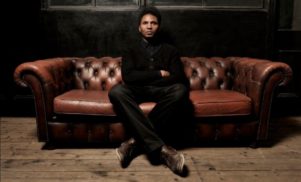Go under the hood with a d’n’b don.
After two decades at the production coalface as a solo act and as part of Bristol’s seminal Reprazent crew, veteran drum’n’bass trooper DJ Krust has more than a few pearls of wisdom to share with the next generation of apprentices.
To mark the release of his slow-building, squelched-out refix of Claude VonStroke’s ‘Oakland Rope’ as part of the forthcoming Urban Animal RMXS album, FACT asked the producer born Kirk Thompson to break down his most vital studio tools and talk about the benefits of an “unthinking” creative process.
Check out Krust’s Claude VonStroke remix below and head to Soundcloud for tasters of the rest of Urban Animal RMXS. Last week the Dirtybird boss also filled us in on his favourite record of all time.
And for more gear nerdery, tuck in to FACT’s guide to The 14 Synthesisers That Shaped Modern Music.
Roland V-Synth
At the heart of my studio is the Roland V-Synth. It’s one of the best synths I’ve used for the kind of thing it does and it’s pretty versatile – it helps shape my sounds and give me endless choice when it comes to manipulating them. This keyboard is the backbone of my unique sound and has taken it in a whole new direction.
The functions are in a league of their own. It allows you to use it in a multi-dimensional way, really – it has something called an Elastic Audio Synthesizer, so when you sample a sound it gives it a smooth, unbelievable texture. Then you can send that sound through all the functions the keyboard has and resample it if you want.
One of my favourite parts of the V-Synth is the Multi Step Modulator. This turns your sound into a kind of rhythm which you can then process. It works well on drums or long sounds. When you add this to key velocity or aftertouch with a filter on the D Beam, and LFO on the Time Trip Pad. You can quickly see how much you can do to the sound – the only limit is your imagination.
Emu E64 Sampler
It’s all about the sound this machine makes – I don’t really sample with this anymore, it’s more of a sound module. The sounds have a different texture or colour, a certain feel which adds layers and depth. Adding this to the digital palette helps make my music a bit more interesting.
I also sometimes use a Minimoog Model D and an ARP Odyssey. The Moog has a broken oscillator and produces some really off-key sounds which have been all over my music for years. The ARP is a classic – a totally different sound from the Moog. Once you leave it for a few days it really starts giving you the goods. I have a JoMoX that’s fun to use for kicks and crazy fat snares. You can pitch the snare down so low it has the weight and fatness of a kick drum slapping you in the face.
Experimenting
Typically I’ll take two to three weeks just to make sounds, so that would be messing around with the synths, putting them through pedals and speaker cabs, finding way-out things to do with them. At this point it’s just trying to make any sound until something happens, then I dive right in and start shaping it. It’s a bit like mining for gold – you know there’s something down there, you just have to keep looking. I enjoy getting lost pushing buttons without thinking about the outcome. It helps me detach, and that way I’m open to whatever happens. As I’m doing that I’m making loops, putting together the building blocks of what will become the puzzle to solve. What I don’t do is worry about key, tempo or EQ. Sometimes I will play riffs with drum sounds and play beats with keyboard sounds. The real aim at this point is to switch the mind off. I’m not thinking, it’s all about feel.
I’m looking at sounds as if they’re colours, vibrations that fit together in a very specific way – or not. Sometimes it’s good if they don’t fit and they don’t want to work together, then that’s an opening for something new to occur. What I’m really doing is feeling new emotions. When I get something that’s not supposed to work I know I’m heading in the right direction. This can take anywhere between a week and a month. What I like about the digital domain is you don’t have to finish anything right away. This is both good and bad…
Pro Tools is my platform of choice, and at this stage I use it like tape. Most of the colouring will come from the samples and keyboards. I’m only interested in rough arrangement for now. As I’m doing this I’m remembering where other sounds are – I keep a little notebook with names of sounds that I’ve collected throughout the sessions. Then I just add to the mix and see what happens.
The interesting thing about working this way is that after about a week you check in and you’ve got 10 or 20 new ideas, things that you might not ever do, but the process allows you the creative freedom because you’re not trying to make a track, you’re just making sounds and loops. I find it more fun approaching it this way, and it has to be fun for the best stuff to appear. After a while I’ll have a batch of loops that are intros or drops or middle sections for songs. This is where the puzzle appears. You now take the loops that you have and start mixing and matching. Anything can happen here – try not to over think it and let your imagination run. At this point I’m not trying to have it make sense. I want to hear something that I’ve never heard before, so this is a good experiment.

































